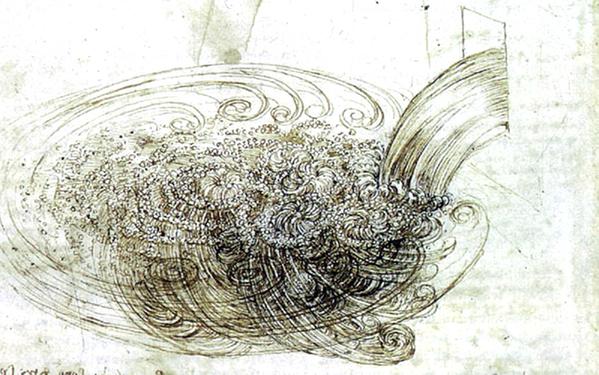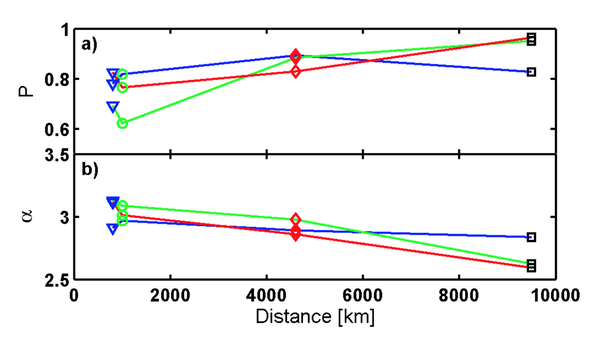Plasma turbulence
Turbulence
Turbulent fluids are characterized by rapidly fluctuating fluid parameters, such as pressure, flow speed and density. Two examples of turbulence in fluids are: atmospheric turbulence, which may cause bumpy airplane rides and the water behind the stern of a moving boat.

Whirlpools of water. Image: Leonardo da Vinci, RL 12660, Windsor, Royal Library.
Turbulence in plasmas
Plasma is a state of matter where ions and electrons have not formed atoms, but exist side-by-side in an ionized gas. Plasma is the most abundant state of ordinary matter in the universe and it is often turbulent. Examples of turbulent astrophysical plasmas are the interstellar medium and the atmosphere of stars. More locally, turbulence is prevalent in several regions in our geospace, such as: the solar wind and ion foreshock region, the magnetosheath, the cusps, the magnetotail, and the ionosphere.

A classic example of turbulence in an astrophysical object: the highly turbulent supernova remnant Crab nebula. Image: NASA, ESA, J. Hester, A. Loll (ASU) Acknowledgement: Davide De Martin (Sky Factory).
Turbulence acts to transfer energy from large-scale motion into small scale motion and heat. In ordinary fluids, this energy dissipation is caused by viscosity in the fluid. In collisionless plasmas, however, energy is dissipated by particles interacting with waves in the plasma. Understanding turbulence is important because it influences particle heating and acceleration, such as solar energetic particles and cosmic rays. It is also important because it heavily influences the structure and dynamics of the Earth's magnetosphere as well as energy and mass inflow to the magnetosphere.
Research
We study plasma turbulence in different regions in space in the solar wind and in the up- and downstream regions formed at planetary bow shocks. We investigate the turbulence properties by in-situ measurements from single spacecraft missions like Ulysses and Venus Express, and multi-point missions like Cluster and THEMIS. We use the ionosphere for stimulus-response type of experiments to study the natural ionosphere as well as complex plasma turbulence, thus using the near-Earth space environment as the world’s largest laboratory. Powerful radio waves are transmitted into the ionosphere from the ground to excite a multitude of plasma phenomena, which are diagnosed primarily by radars, cameras and other ground-based instruments. The facilities used include that of EISCAT in northern Scandinavia, HAARP and PFISR in Alaska, USA. The latter two facilities have enabled the first experiments with twisted electromagnetic beams interaction with the plasma.

The colors represent the magnetic field components – BX (blue), BY (green), and BZ (red), with the Cluster spacecraft symbol for each estimation of the intermittency parameter P; α is the spectral slope. From a study of turbulence evolution downstream quasiparallel bowshock in the terrestrial magnetosheath. It is shown that: there is clear anisotropy of the turbulence with respect to the shock normal. The intermittency of the magnetic field components in the shock plane shows fast development from lower to higher values, while the component along the bow shock normal shows no clear evolution. Image: Yordanova, E. et al., PRL., 100, 205003, 2008.
Our research is focused on turbulence structure and mechanisms of generation, evolution and dissipation. Some science questions we have are:
– How is turbulence generated in the solar atmosphere, at which scales it is driven?
– How does turbulence evolve spatially and temporally throughout the heliosphere?
– How is energy transferred through different scales?
– How is energy dissipated, at which scale and by what mechanisms?
– What is the source of intermittency and related coherent structures?
– How is turbulence affected by anisotropy?
– How do bow shock parameters affect and modify upstream and downstream turbulence?
Our team
Further reading
1. E. Yordanova, S. Perri, L. Sorriso-Valvo, and V. Carbone, Multipoint observations of anisotropy and intermittency in the solar wind turbulence, EPL, 110, 19001, (2015).
2. E. Yordanova, S. Perri, and V. Carbone, Reduced magnetic helicity behavior in different plasma regions of the near-Earth space, JGR, 116, A7, 2010JA015875, (2011).
3. E. Yordanova, A. Balogh, A. Noullez, and R. von Steiger, Turbulence and intermittency in the heliospheric magnetic field in fast and slow solar wind, J. Geophys. Res., 114, A08101, doi:10.1029/2009JA014067, 2009.
4. E. Yordanova, A. Vaivads, M. André, S. C. Buchert, and Z. Vörös, Magnetosheath plasma turbulence and its spatiotemporal evolution as observed by the Cluster spacecraft, Phys. Rev. Lett., 100, 205003, 10.1103/PhysRevLett.100.205003, (2008).
5. A. Retinò, D. Sundkvist, A. Vaivads, F. Mozer, M. André and J. Owen, Insitu evidence of magnetic reconnection in turbulent plasma, Nature Physics, vol.3, (2007).
6. D. Sundkvist, A. Retinò, A. Vaivads and S. D. Bale, Dissipation in Turbulent Plasma due to Reconnection in Thin Current Sheets, PRL 99, 025004 (2007).
